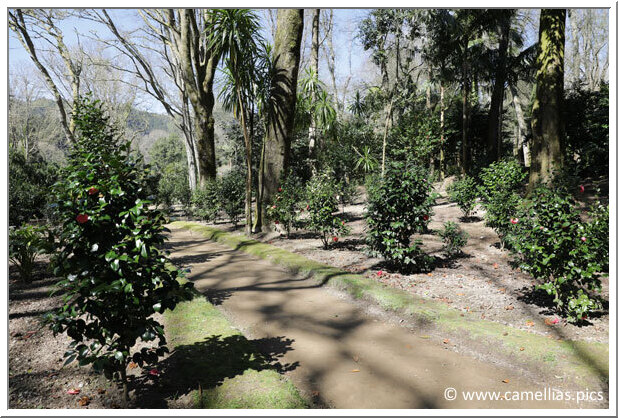Here is the Terra Nostra Park, a must for camellias lovers during a trip to São Miguel (Azores). It is today a camellias conservatory. Thomas Hickling, from an English family of traders who migrated to Boston, moved to the Azores at the time of US independence to ensure exports between the Azores and the United States. The property is redeemed and embellished in the mid-nineteenth century with the planting of exotic trees. At that time, it had 500 camellias. Recently, the park received new plants, more than 650 different cultivars today, 550 of them are identified and named. There are Portuguese camellias and camellias from around the world, in a very complete collection that continues to grow. It is also one of the most beautiful tourist sites of São Miguel.
The optimum period to enjoy the camellias collection is mid-February. We were there mid March, but there still were flowers. This page is mainly dedicated to Portuguese varieties, but also to the variety of camellias planted in the park. This one is divided, for the camellias, in several sectors: species, sasanqua, reticulata, hybrids and japonica, with camellias of very varied sizes, from seedlings to big and old subjects. There was no flower left for sasanqua and very little for species. To visit the complete camellias collection, plan a full day or two half days, which we did. Terra Nostra Park has been recognized Garden of Excellence by the ICS.

You can easily park in the city just a few minutes walk from the entrance.

Above, the thermal water basin. The water, at the source, springs at a temperature between 35 and 40°C. It is rich in essential minerals, you can swim there.


The camellias are very present throughout the visit. You will be given a map at the entrance.


A first sector of japonica
They are the majority and they can be found in many areas of the park. Here is a fairly recent plantation, with still young subjects.

As the vegetation of the park is very varied, going from one camellias sector to the other we discover a completely different landscape.

The reticulata sector
Welcome to the reticulata sector, to visit a little later in the season, for optimum flowering. In mid-March, it was perfect. The bloom is very spectacular, it's beautiful. And the collection is very rich.




The hybrid sector
It was still very flowery. We find hybrids from around the world.




The second sector of japonica
This is the second sector of japonica, the biggest, with larger subjects. It is also the richest, because it is spread little by little. Camellias of all sizes, beautiful subjects, and young subjects are found in the course. This is where we found the most Portuguese varieties.

Here is 'Dona Herzília de Freitas Magalhães', the most famous Portuguese Camellia, found throughout Europe, but rarely with its true color.

We arrive in the area of planted more recently camellias.

Below, two other Portuguese camellias

The sasanqua sector
To see in autumn.

We finish our visit with a walk in the rest of the park. The botanical collection is extremely rich. There are rarities, such as the Australian pine 'Wollemia nobilis' in the Cicadales Garden, considered a living fossil.























